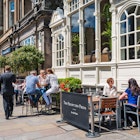
Burns Night feasting, a guide to Scotland's national supper
Dec 6, 2019 • 5 min read

Held every year on the 25th of January, Burns Night is Scotland’s national celebration marking the life and works of the country’s most famous poet, Robert Burns. At the end of the day at gatherings large and small, people come together for Burns Suppers – lively evening feasts that are filled with history and ritual through music, song and poetry as well as traditional local dishes, from cock-a-leekie soup to the illustrious haggis, and of course much Scotch whisky. Read our guide to Burns Night feasting to discover what to expect from this 200-year-old tradition.

What is Burns Night?
Born in west Scotland near Ayr on the 25th of January, 1759, Robert Burns went on to become a prolific poet and is considered Scotland’s National Bard. His works are written mostly in Scots, a native language from the Scottish Lowlands, the most famous of which around the world is that hallmark New Year’s Eve ballad, 'Auld Lang Syne'.
Proudly Scottish, Burns is renowned for his ability to use humour and wit to celebrate themes of love, nature and social equality through his poetry. Burns Night commemorates his life and works each year on the 25th of January, where people gather in the evenings to host and attend boisterous Burns Suppers.
What happens at a Burns Supper?
Following Burns’ death in 1796, the first Burns Supper was held in 1801 by a group of his friends at Burns Cottage in Alloway. There’s now a typical running order that takes place during the evening, starting off with grace and finishing up with everyone singing and dancing together.
To kick off the night, it’s usually the 'Selkirk Grace', a rendition of the mealtime prayer as spoken by Burns while dining with the Earl of Selkirk in 1793:
Some hae meat and canna eat
And some wad eat that want it
But we hae meat and we can eat
An sae the Lord be thankit

There are many modern dishes that might be served up at a Burns Supper, but the Bill o’ Fare – that’s Scots for ‘menu’ – is likely to feature any number of classic Scottish plates. January is one of the coldest months in Scotland, so it follows that the starter served is often a warming soup – it could be Scotch broth, made with barley, root vegetables and tougher cuts of lamb or beef that are best when slow-braised; the hearty mix of chicken, peppercorns, prunes and leeks known as cock-a-leekie; or cullen skink, a rich, chowder-style dish made with smoked haddock, onions and potatoes.

Then, the haggis is piped in: a piper plays the bagpipes as the haggis, typically sitting on a large platter, is ceremoniously brought over to the dinner table before the 'Address to a Haggis' (more on that below).
Haggis is the subject of much curiosity, and often – unfairly – bad press. Traditionally, it was made using sheep’s offal, including the heart, lungs and liver, mixed with oatmeal and plenty of pepper and spices, encased in a sheep’s stomach and boiled whole. These days, the filling is often made with lamb and beef and kept in regular sausage casings, served warm by sautéeing the heady mixture. What does it taste like? Imagine a deliciously peppery, spiced, crumbly sausage.
Now, back to the Address. 'Address to a Haggis' is Burns’ ode to the national dish of Scotland, first published in 1787. During Burns Suppers, it can be recited as a poem, or more theatrically with the stanzas acted out. Say, the orator might dramatically slice into the haggis to reveal steam from the piping-hot dish when it comes to this verse:
His knife see rustic Labour dight,
An cut you up wi ready slight,
Trenching your gushing entrails bright,
Like onie ditch;
And then, O what a glorious sight,
Warm-reekin, rich!

Once the address is over, the haggis is plated up usually with boiled, mashed neeps (turnips) and tatties (potatoes), followed by a main course – it might be roast salmon, beef or game. The most typical desserts are cranachan – toasted oatmeal folded through cream and raspberries, sweetened with honey and served in glasses – or Scotch trifle, which layers up whisky-soaked sponge cake, berries, cream, custard and flaked almonds. You might also see it referred to as a tipsy laird, ‘laird’ being the Scots word for lord.
During the meal, guests or the host might stand up and recite Burns’ beloved poems, including 'Tam o’ Shanter', 'To A Mouse' and 'A Red, Red Rose'. Afterwards, you’ll hear the 'Immortal Memory of Robert Burns' – a speech in honour of his legacy – followed by the ‘Toast to the Lassies’ and the ‘Reply to the Toast to the Lassies’. Finally, it will all wrap up with a group rendition of 'Auld Lang Syne', where guests gather round in a circle, cross arms and hold hands, singing the famous tune all together.
How to attend a Burns Supper
Burns Night sees all manner of Burns Suppers hosted across Scotland (and around the world, too), from relaxed dinners in pubs to more contemporary affairs in restaurants. Robert Burns inspired many a club and society, which host a dearth of these events. If you are in Scotland on the 25th of January – the Robert Burns World Federation shares events from some 250 chapters around the world, and check out the VisitScotland events page for a range of local listings. And if you're in the Scottish capital on any other day of the year, check out our guide to Edinburgh's best restaurants for a feast of your own!
Explore related stories

Wildlife & Nature
The 11 best things to do in Scotland from spotting puffins to bagging peaksOct 15, 2024 • 8 min read

 Festivals & EventsThe best times to visit Scotland from summer festivals to cozy winter nights
Festivals & EventsThe best times to visit Scotland from summer festivals to cozy winter nightsOct 14, 2024 • 5 min read

 Art and CultureYou'll see this everywhere: traditional Breton music and dancing
Art and CultureYou'll see this everywhere: traditional Breton music and dancingJul 15, 2024 • 5 min read


 AstrotourismA reason to visit Scotland's Isle of Coll: a pop-up nightclub on a dark-sky island
AstrotourismA reason to visit Scotland's Isle of Coll: a pop-up nightclub on a dark-sky islandJun 3, 2023 • 4 min read


